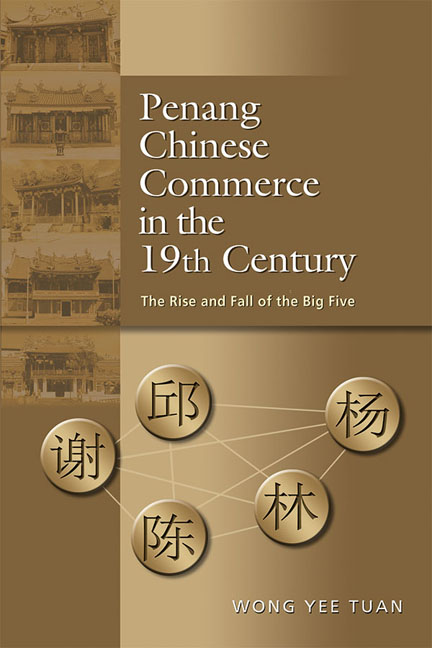Book contents
- Frontmatter
- Dedication
- Contents
- List of Tables, Diagrams and Maps
- Acknowledgements
- Glossary
- Abbreviations and Acronyms
- Notes on Spelling and Names
- Notes on Currencies
- Map
- 1 Introduction
- 2 Penang and the Big Five in Regional Context
- 3 Kith and Kin: The Big Five Familial Web
- 4 Opium Farm Rivalry
- 5 The Contest for ‘White Gold’
- 6 Western Mercantile Elite and Their Challenge to the Penang Chinese
- 7 New Regional Order and the Decline of the Big Five
- 8 Conclusion
- Appendices
- Bibliography
- Index
- About the Author
- Platesection
- Map
6 - Western Mercantile Elite and Their Challenge to the Penang Chinese
Published online by Cambridge University Press: 19 May 2017
- Frontmatter
- Dedication
- Contents
- List of Tables, Diagrams and Maps
- Acknowledgements
- Glossary
- Abbreviations and Acronyms
- Notes on Spelling and Names
- Notes on Currencies
- Map
- 1 Introduction
- 2 Penang and the Big Five in Regional Context
- 3 Kith and Kin: The Big Five Familial Web
- 4 Opium Farm Rivalry
- 5 The Contest for ‘White Gold’
- 6 Western Mercantile Elite and Their Challenge to the Penang Chinese
- 7 New Regional Order and the Decline of the Big Five
- 8 Conclusion
- Appendices
- Bibliography
- Index
- About the Author
- Platesection
- Map
Summary
Before the 1880s, direct competition from Westerners was insignificant since they had only a peripheral interest in the region and played an auxiliary role as providers of capital. However, the Western mercantile elite began to pose a competitive threat to the Big Five from the mid-1880s, a period which saw a shift from liberalism to management characterized by increasingly powerful colonial governments and rapid expansion of Western interests in trade, shipping, and insurance. This chapter explores the Western competition in this Penang-centred region and the countermeasures taken by the Big Five. It first examines the shipping and trading intrusions made by the large-scale and financially-powerful Western business concerns. It then turns to the response of the Big Five towards the Western challenge.
From Liberalism to Management
The unprecedented Western penetration into the commercial orbit of Penang in the late nineteenth century was not simply a response to its profitable trade and commerce. It was also a result of intensifying international economic expansion and political rivalry. The last decades of the nineteenth century witnessed the change in the global economy from commercial to industrial capitalism.1 As such industrial production became the engine of growth and the key to wealth and power in the West. From this period, Britain, until then the leading industrial power in the world economy, faced fierce competition from new Western industrial powers like Germany, France, Holland, and America.2 The challenge to Britain from these Western powers heralded an intense scramble for resources. Hence, Southeast Asia became more fully open to the impact of the Industrial Revolution and more Western states showed increasing interest in the region. In order to consolidate their control of economic resources and opportunities, the British and the Dutch, who had firmly established themselves in Southeast Asia, began to delineate their respective business spheres. To achieve this, corporate enterprises were organized to penetrate into all the major business sectors while state power was centralized to support this business thrust and, at the same time, to annex territories in contention and solidify colonial boundaries.
These new Western corporate enterprises were different from the Penang-based Western trading and entrepreneurial interests which had been established in the early-to- mid nineteenth century. They were incorporated companies, representing large capital resources and business interests centred mainly in the Western metropolitan cities.
- Type
- Chapter
- Information
- Penang Chinese Commerce in the 19th CenturyThe Rise and Fall of the Big Five, pp. 102 - 136Publisher: ISEAS–Yusof Ishak InstitutePrint publication year: 2015

